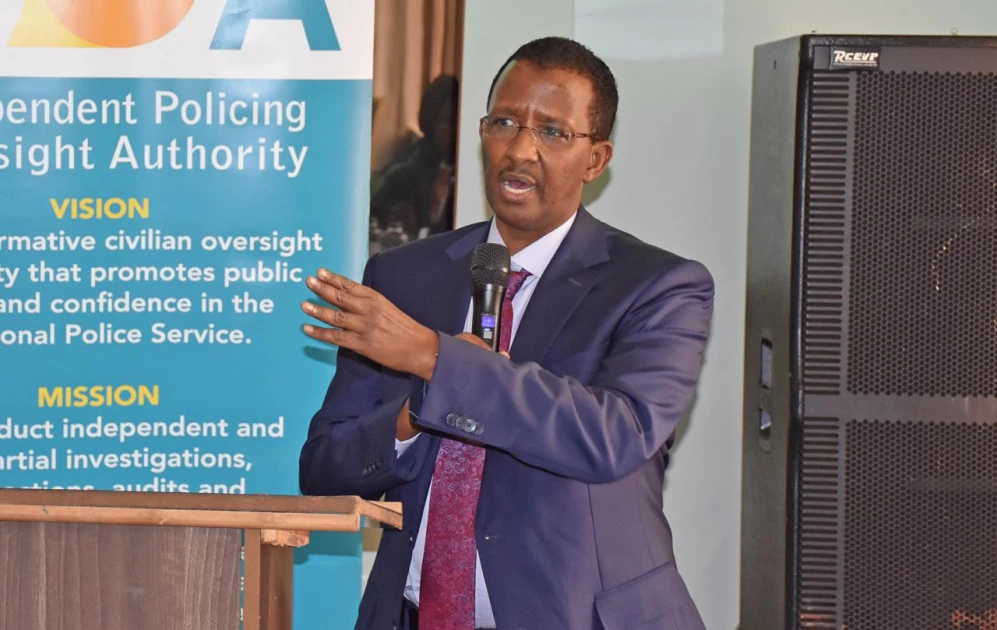IPOA flags police abuses, excessive force in handling of recent protests

According to the July 2025 report, police officers deployed during demonstrations in June and July operated without displaying name tags or service numbers.
A new report by the Independent Policing Oversight Authority (IPOA) has revealed alarming misconduct by police during recent nationwide protests sparked by the death of Albert Ojwang’ in custody, raising questions over transparency, accountability, and the use of force by security agencies.
According to the July 2025 report, police officers deployed during demonstrations in June and July operated without displaying name tags or service numbers contrary to the law and were accompanied by unidentified plainclothes individuals wielding whips, casting further doubt on the legality of their presence in protest management.
The protests began on June 12 in Nairobi, with demonstrators demanding justice for Ojwang’, whose death while in police custody remains under investigation.
Although organizers reportedly failed to issue formal notification under the Public Order Act, IPOA noted the protest remained largely peaceful and ended without incident.
Despite the calm, heavily armed officers both in uniform and civilian clothing were deployed. They blocked major roads including Harambee Avenue, Parliament Road, City Hallway, and access to the National Treasury.
IPOA observers reported that none of the officers bore visible identification, violating Schedule Six of the National Police Service Act.
More disturbingly, the report cites the presence of plainclothes civilians participating in enforcement activities an apparent breach of public order policing regulations.
A second round of demonstrations followed on June 17 in Nairobi and Mombasa, this time targeting Deputy Inspector General Eliud Lagat. In Nairobi, IPOA reported the deployment of officers from the GSU, CIPU, and regular police many in riot gear and noted that some police vehicles had obscured number plates.
During this protest, a demonstrator, Boniface Mwangi Kariuki, was shot and later died in hospital. IPOA investigated the incident and forwarded the file to the DPP. Police officer Klinzy Masinde Barasa has since been charged in connection with the shooting, in Criminal Case No. 010 of 2025.
IPOA also flagged incidents where unknown individuals infiltrated protests carrying crude weapons, contributing to the chaos. No police injuries were recorded during the Nairobi protest, but violence erupted elsewhere.
The watchdog paints a broader picture of deteriorating protest policing across multiple counties, citing 65 civilian deaths, 342 injuries to protesters, and 171 injuries to police officers during the June–July unrest. Yet, the National Police Service only officially acknowledged five of the civilian deaths, undermining IPOA’s oversight mandate.
The authority attended 61 autopsies and continues investigations into unresolved cases.
The report also faulted the police for consistently treating protests as riots rather than constitutionally protected assemblies under Article 37, and for failing to act against violent counter-protesters.
Widespread destruction of property was also documented, including the burning of police stations in Nairobi, Kirinyaga, and Nyandarua, and looting of public and private institutions in counties such as Meru, Embu, Nakuru, Kiambu, and Makueni.
In Meru, Magunas Supermarket was looted while hospitality and transport facilities were damaged. Embu saw Red Cross and KRA vehicles vandalized alongside attacks on banks and retail outlets. Similar destruction was noted in Bungoma, Kakamega, Kisii, and Kajiado, with police reportedly overwhelmed in many instances.
On operational conduct, the report was damning: officers lacked meals, water, and allowances during deployments, raising concerns about their welfare. Additionally, there was no evidence of medical support teams or ambulances being deployed during the protests, a clear breach of statutory obligations.
The watchdog further noted that the use of unmarked vehicles, hidden license plates, and failure to identify officers severely limited accountability.
Only in Mombasa did IPOA observe a disciplined, proportionate, and rights-compliant approach to protest policing.
The report urges urgent legal and institutional reforms. Among IPOA’s key recommendations are the mandatory use of body-worn cameras and video evidence during protests, deployment of medical teams and ambulances, provision of proper welfare for officers, and the formation of a Public Hospital Security Unit to safeguard health facilities during volatile operations.
IPOA also proposes the development of a comprehensive national public order management policy in collaboration with Parliament and the Inspector General of Police. This policy would clarify the legality of spontaneous protests, encourage constructive engagement with demonstrators, and strengthen coordination with civil society actors.
The Authority is also calling for a national civic education campaign on protest rights, stronger community policing structures, and activation of County Policing Authorities to improve grassroots oversight.
In a final appeal, IPOA is urging the National Police Service to launch transparent recruitment to address the country's worsening police-to-citizen ratio, currently at 1:600 well below the recommended 1:450.
